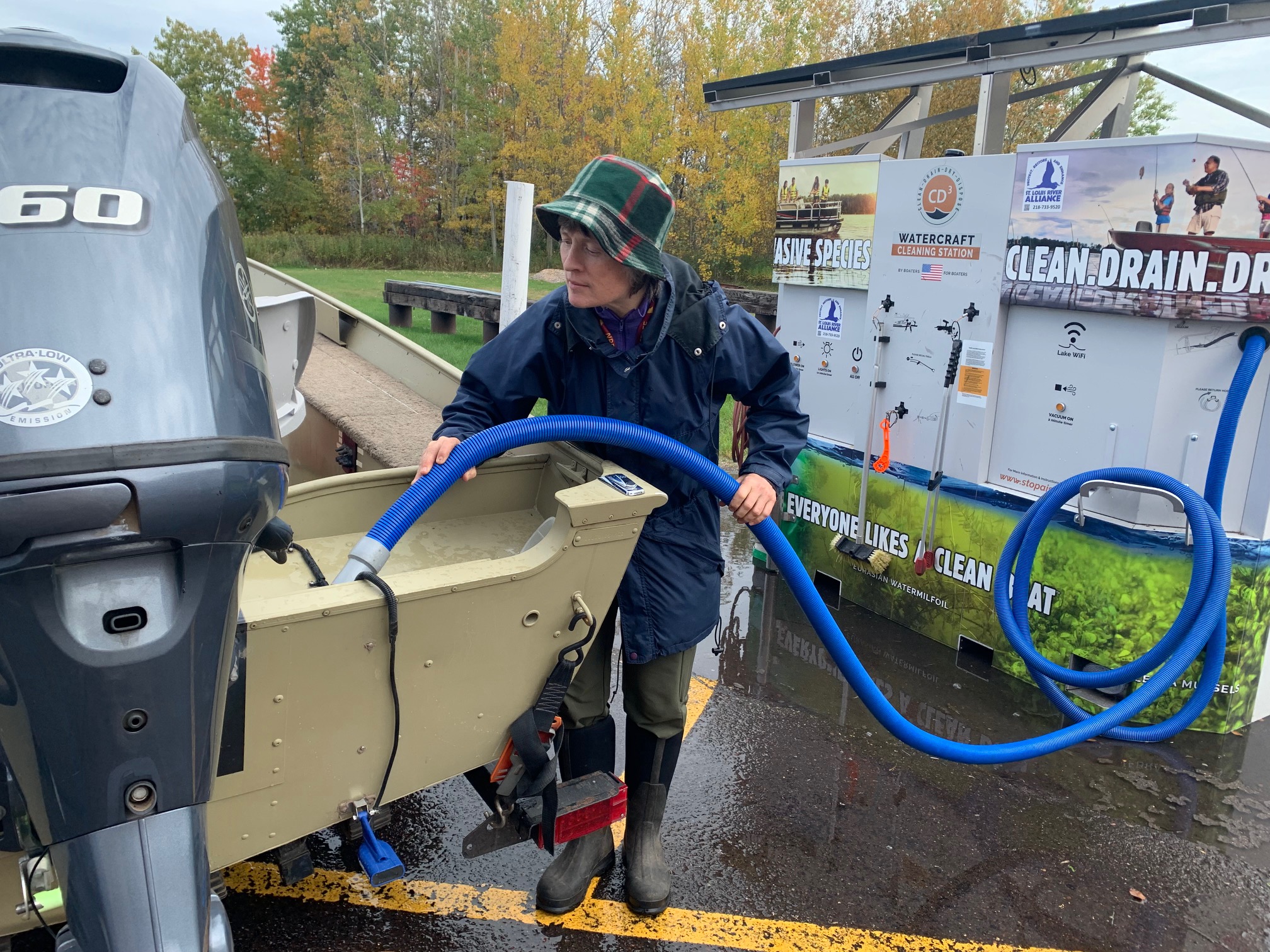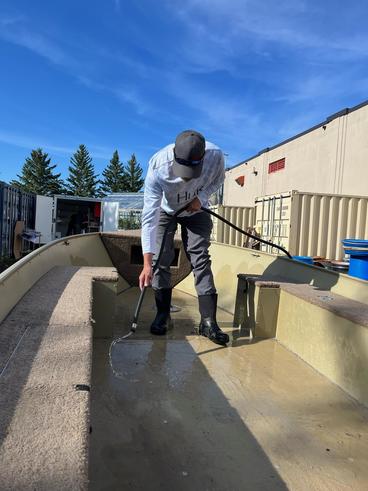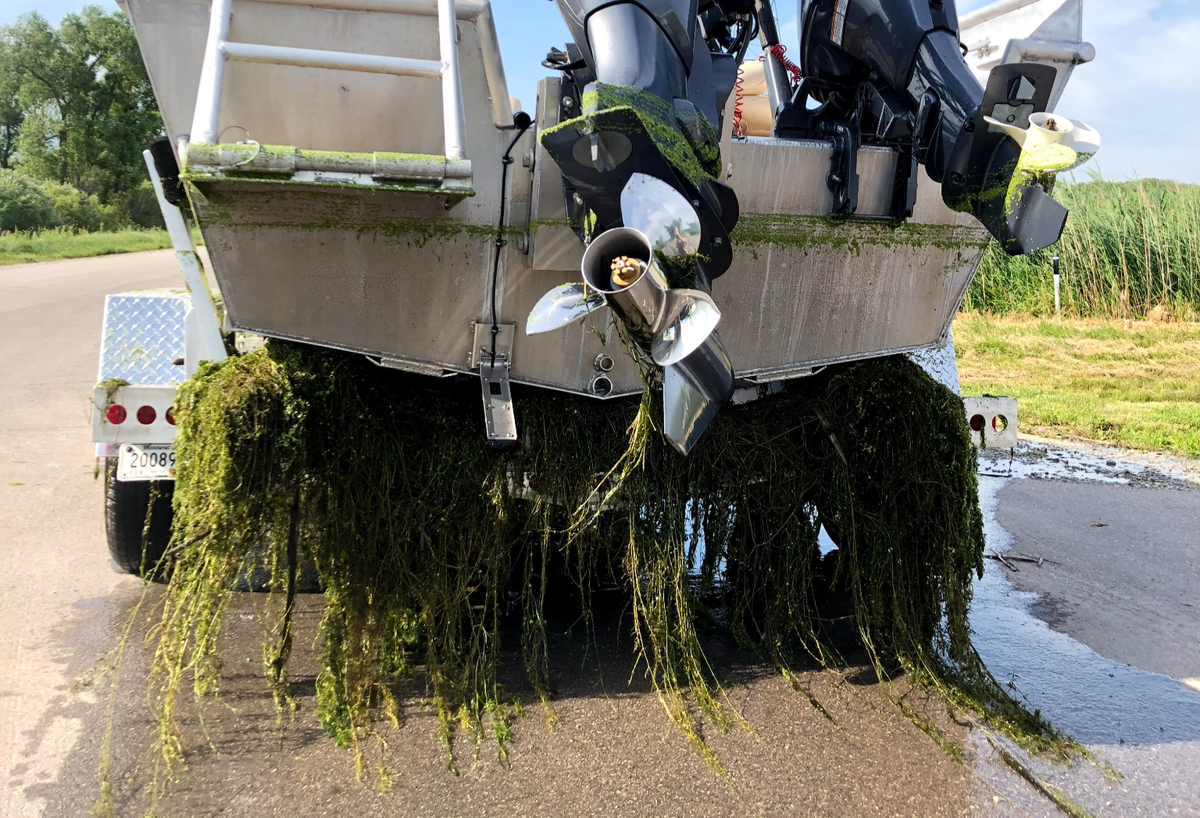Island Lake Reservoir in St. Louis County is a popular fishing destination. It’s home to walleye, northern pike, bass and panfish. Unfortunately, invasive spiny water fleas have also found their way into the freshwater lake.
Nearby Pike Lake, also well known to anglers, is heavily infested with zebra mussels. So when boats move between these lakes, they could be sharing invasive species. These invasions alter food webs, degrade habitat and can lead to population declines of native fish.
“Hauling recreational boats between lakes is one of the primary ways that aquatic invasive species are spread from lake to lake,” said NRRI Aquatic Scientist Holly Wellard Kelly. “Over 800 lakes in Minnesota are currently infested with some type of invasive species, but we still have some 10,000 that we can protect.”
Clean. Drain. Dry.
Can the well-known mantra “Clean. Drain. Dry.” solve the problem? Research has verified that removing aquatic plants and other invasive species from boats, motors and trailers, then allowing everything to dry out before going to another lake is the most effective way to protect lakes.

That’s why Minnesota invests $10 million annually for aquatic invasive species (AIS) prevention efforts, including installing boat cleaning stations at many landings. The self-service stations provide tools like vacuums, compressed air and scrub brushes, to remove invasive hitchhikers and help remove water from boats. And it works. Their effectiveness at cleaning the exterior of boats and trailers is well studied.
But fishing gear and anchors can bring invasive species into the boat as well, and effective cleaning of the boat interior has not been well studied.
So NRRI funded an initial pilot study and then broadened it to determine what common cleaning methods available at boat launches will get AIS out of a boat’s interior. The team received funding from the Minnesota Environment and Natural Resources Trust Fund and was loaned a waterless cleaning station from CD3 – one of the primary manufacturers of these stations based in Minnesota – with support from the City of Duluth.
“If there aren’t tools at the landing, all you can do is pick things off by hand, or some will have a low pressure garden hose,” said Wellard Kelly. “So we wanted to compare those techniques with the tools on a cleaning station.”
Boat Prep
The researchers replicated what might get into an angler’s or waterfowler’s boat. They “spiked” NRRI’s Lund Alaskan boat with a combination of preserved invasive invertebrates, surrogates for invasive vegetation (such as pieces of grass), and ribbon pieces for tracking where things went.
And because waterfowl hunters boat into waters with tall vegetation, they might also pick up seeds and snails, so the researchers spiked a boat with those items as well.
“Then we messed up the boat,” said Wellard Kelly. “We counted our ‘invasives’ and mixed them with water, then poured them into the boat. We even mixed them into a mud slurry and poured it into the waterfowler boat.”

The researchers goal was to simulate how they think anglers would actually clean their boats and livewells. Then, knowing exactly what was spiked into the boat, they counted exactly what was recovered. To mimic what a boater might do, each cleaning step was limited to no more than seven minutes.
Results
In the angler boat, combining all methods – hand picking, garden hose and wet vac – removed nearly 95 percent of invasive plant surrogates. Hand picking alone worked well for vegetation that’s easy to see, but not for removing tiny spiny water fleas. And flushing with the garden hose alone trapped some vegetation in the stern of the boat or under the boat floor.
In the waterfowler boat, the mud made it hard to hand pick the small stuff. But large snails and larger vegetation could be effectively hand-picked. Again, using all methods consistently worked well at removing the debris.

“And the vacuum did awesome because you can see the dirt and you’re getting everything stuck in that dirt out of the boat,” said Wellard Kelly. “That’s the most important thing…getting as much as possible out of the boat so it can’t be transported to another lake.”
Cleaning out the livewell proved to be a bit more complicated. It takes more than just pulling the plug.
“With spiny water fleas, 80 percent of them washed out just by pulling the plug on the live well. That’s pretty good,” said Wellard Kelly. “But not so much for the vegetation. Things were either getting retained in the livewell or stuck in the corrugated drain tubing.”
But a repurposing of the compressed air wand – provided mostly to dry a boat quickly – to blow stuck vegetation and water fleas out of the livewell drain tubing worked well.
Recommendations
Overall, cleaning tools provided at boat landings are effective. And the whole process can be done quickly, in about seven minutes.
“People should be using them,” Wellard Kelly added. “Especially the vacuum, which worked really, really well. And it’s waterless, so you’re not adding water when your goal is to dry your boat.”
State funding to supply and maintain the vacuums and other tools at boat landings is very important. Effectiveness also depends on the species needing removal and the order tools are used: first vacuum (if available), then hand pick, rinse (if hose is available), and finally, vacuum out remaining water.
They also recommend improved signage based on which invasives are in each lake, adding more air compressors to the cleaning stations, and specifying the order and way tools should be used.
The CD3 company is incorporating NRRI’s research results into their website to better explain effective cleaning to boaters.
“If they know there’s an invertebrate invader in a lake, anglers need to know which tool is going to be most effective at removing it,” she said. “So each lake needs the right tools, and best practices for using the tools.”
And complete drying of the boat and equipment over multiple days is still recommended whenever possible.
This project was funded by the Minnesota Environment and Natural Resources Trust Fund. The team is developing a report which will be submitted to the Legislative-Citizen Commission on Minnesota Resources in late June and is writing a peer-reviewed paper to share their findings. They will also share information at several national invasive species and lake management meetings this fall.
Check to see if your favorite fishing lake is infested:
Minnesota Department of Natural Resources Infested Waters Map
